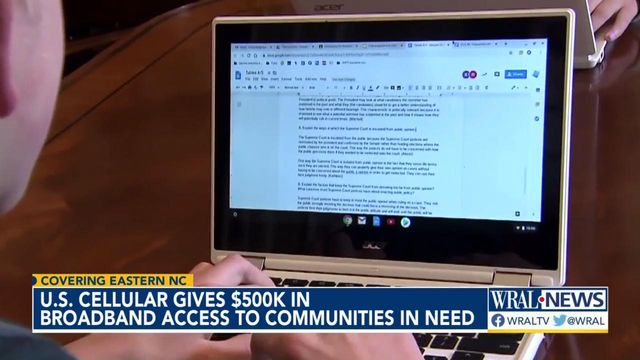US Cellular gives more than $500,000 in hotspots to eastern NC students without internet access
Communities across eastern North Carolina are getting more than half a million dollars in support for broadband access thanks to a gift from U.S. Cellular.
Posted — UpdatedLeaders of the Boys & Girls Club in the region say the hundreds of hotspots they’re receiving will make an impact on some of the most profound broadband deserts in the state.
“For the young people at our club, these hotspots will provide access,” said Donyell Jones, CEO of Boys & Girls Club North Central NC.
U.S. Cellular chose eastern North Carolina for the largest broadband donation in the company’s history. As part of the effort, 330 hotspots have been delivered to the Boys & Girls Clubs in Henderson and Roanoke Rapids, and 140 more hotspots have been given to the club in Sanford.
A spokesperson for the company said the hotspots would be shared by Boys & Girls Clubs in Lee, Chatham, Harnett, Warren, Franklin, Granville, Vance and Halifax counties.
U.S. Cellular told WRAL News the internet service on the devices has been paid for over at least the next two years.
“These hotspots allow students to span that digital divide, and use these not just here at the club, the Boys & Girls Club here in Vance County, but from their home,” said Jeremy Taylor, eastern North Carolina sales director for U.S. Cellular.
That way, Taylor said, students have access to the internet for their schoolwork.
A spokesperson for U.S. Cellular said some of the hotspots would also be loaned out to directly to families, providing an ability to connect from home that has been sorely needed in the eastern part of the state.
Data from the National Telecommunications and Information Administration showed 27.6% of homes in Roanoke Rapids don’t have internet access. That figure rises to 30% for homes in the Henderson area and nearly 45% of households in Sanford don’t have any access at all to the internet.
“Usually for some of the kids in rural communities, the only place where they may have an opportunity to connect is at school and at our clubs,” Jones said. “It eliminates the barriers and challenges to them being academically enriched.”
After losing out on more than a year in the classroom, leaders of the Boys & Girls Club hoped the new tools could help students in eastern North Carolina to get their education back on track.
“In rural communities, connectivity is one of the barriers that eliminates opportunities for some of the young people that we serve,” Jones said. “So this levels the playing field, and allows them to have the same advantages of any young person in our community.”
• Credits
Copyright 2024 by Capitol Broadcasting Company. All rights reserved. This material may not be published, broadcast, rewritten or redistributed.






